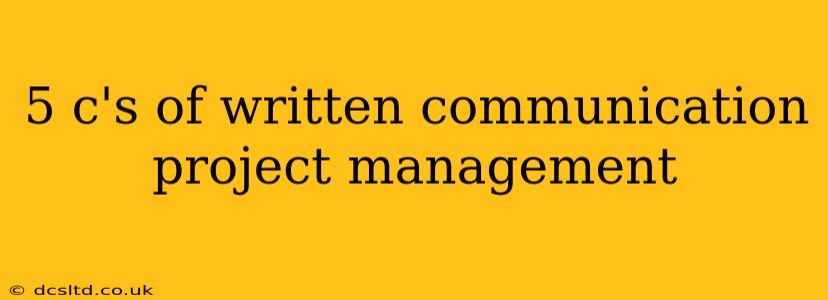Effective written communication is the backbone of successful project management. In the fast-paced world of projects, miscommunication can lead to delays, cost overruns, and even project failure. Mastering the five C's – Clarity, Conciseness, Correctness, Coherence, and Courtesy – ensures your written communications are understood, respected, and ultimately, effective. This guide will delve into each "C," providing practical examples and strategies to elevate your project management writing.
1. Clarity: Making Your Message Crystal Clear
Clarity is paramount. Your message must be easily understood by your audience, regardless of their technical background. Avoid jargon, ambiguity, and complex sentence structures. Use simple, straightforward language that leaves no room for misinterpretation.
- Example of Poor Clarity: "The deliverables for phase two require a synergistic integration of the core competencies across all functional silos."
- Example of Good Clarity: "We need to combine the expertise from all teams to complete phase two's tasks."
Strategies for Achieving Clarity:
- Know your audience: Tailor your language and tone to their understanding.
- Use active voice: Active voice is more direct and easier to understand than passive voice.
- Define acronyms and jargon: Explain any technical terms your audience might not know.
- Use headings and bullet points: Break up large chunks of text to improve readability.
2. Conciseness: Getting Straight to the Point
In project management, time is of the essence. Conciseness ensures your message is delivered efficiently without sacrificing clarity. Avoid unnecessary words, phrases, and rambling sentences. Get straight to the point and deliver the key information quickly.
- Example of Poor Conciseness: "Due to the fact that we experienced some unforeseen circumstances and challenges, the project timeline has unfortunately been impacted and requires a slight adjustment."
- Example of Good Conciseness: "Unforeseen challenges have impacted the project timeline, requiring a minor adjustment."
Strategies for Achieving Conciseness:
- Cut unnecessary words: Eliminate filler words and phrases like "very," "really," and "actually."
- Use strong verbs: Strong verbs convey more information in fewer words.
- Get to the point quickly: State your main point early in the communication.
- Use bullet points and numbered lists: Organize information concisely.
3. Correctness: Ensuring Accuracy and Professionalism
Errors in grammar, spelling, and punctuation can undermine your credibility and make your message seem unprofessional. Always proofread your work carefully before sending it. Consider using grammar and spell-check tools, but remember these are not foolproof.
- Example of Poor Correctness: "Their going to be late submitting the report."
- Example of Good Correctness: "They are going to be late submitting the report."
Strategies for Achieving Correctness:
- Proofread carefully: Read your communication slowly and deliberately, checking for errors.
- Use grammar and spell-check tools: These tools can help catch errors you might miss.
- Have someone else proofread your work: A fresh pair of eyes can catch mistakes you might overlook.
- Follow style guidelines: If your organization has specific style guidelines, follow them consistently.
4. Coherence: Maintaining a Logical Flow
Your written communication should be easy to follow and understand. Maintain a logical flow of ideas, using transitions to connect sentences and paragraphs smoothly. Ensure your points build upon each other in a coherent manner.
Strategies for Achieving Coherence:
- Use transitional words and phrases: Words like "however," "therefore," and "in addition" help connect ideas.
- Organize your thoughts logically: Present information in a clear and organized manner.
- Use headings and subheadings: Break up large chunks of text to improve readability.
- Summarize key points: Recap your main points at the end of your communication.
5. Courtesy: Showing Respect and Professionalism
Courtesy involves showing respect for your audience and maintaining a professional tone. Avoid using slang, jargon, or offensive language. Be polite and considerate in your writing, even when delivering difficult news.
Strategies for Achieving Courtesy:
- Use a professional tone: Maintain a respectful and formal tone throughout your communication.
- Use polite language: Use words like "please" and "thank you" when appropriate.
- Be mindful of your audience: Consider your audience's perspective and tailor your communication accordingly.
- Proofread for tone: Ensure your communication conveys the intended tone and avoids unintentional rudeness.
By mastering these five C's – Clarity, Conciseness, Correctness, Coherence, and Courtesy – you can significantly improve your written communication in project management, fostering better teamwork, reducing misunderstandings, and ultimately, leading to more successful projects. Remember, clear and concise communication is an investment in your project's success.
